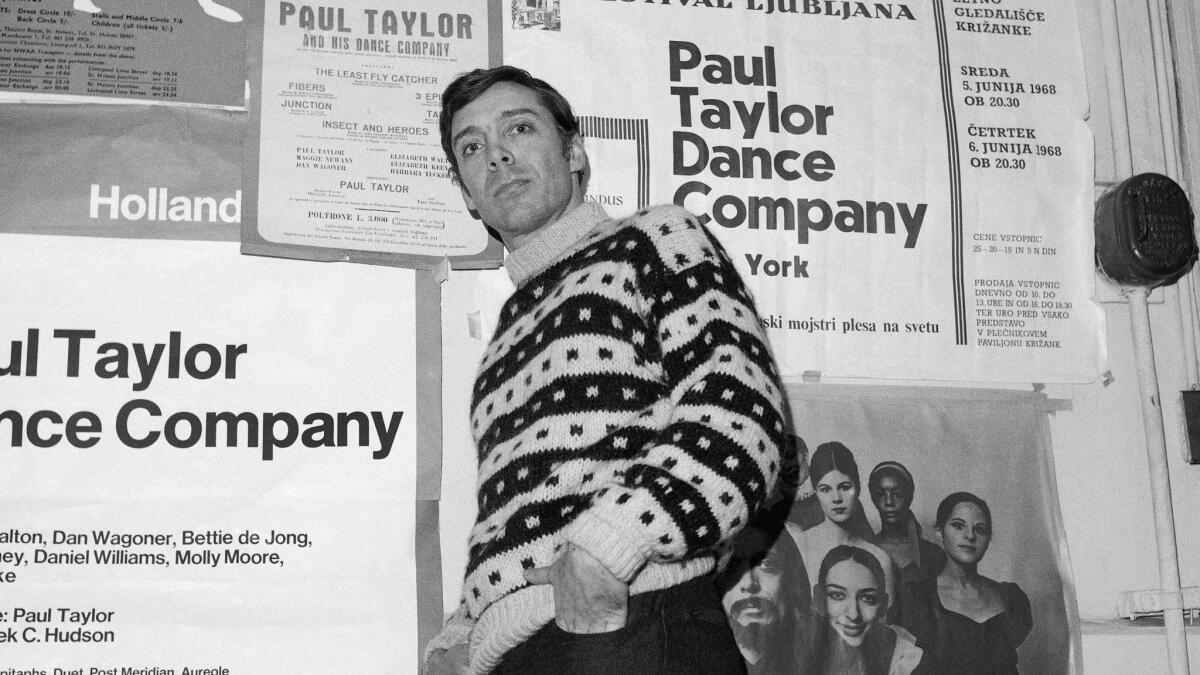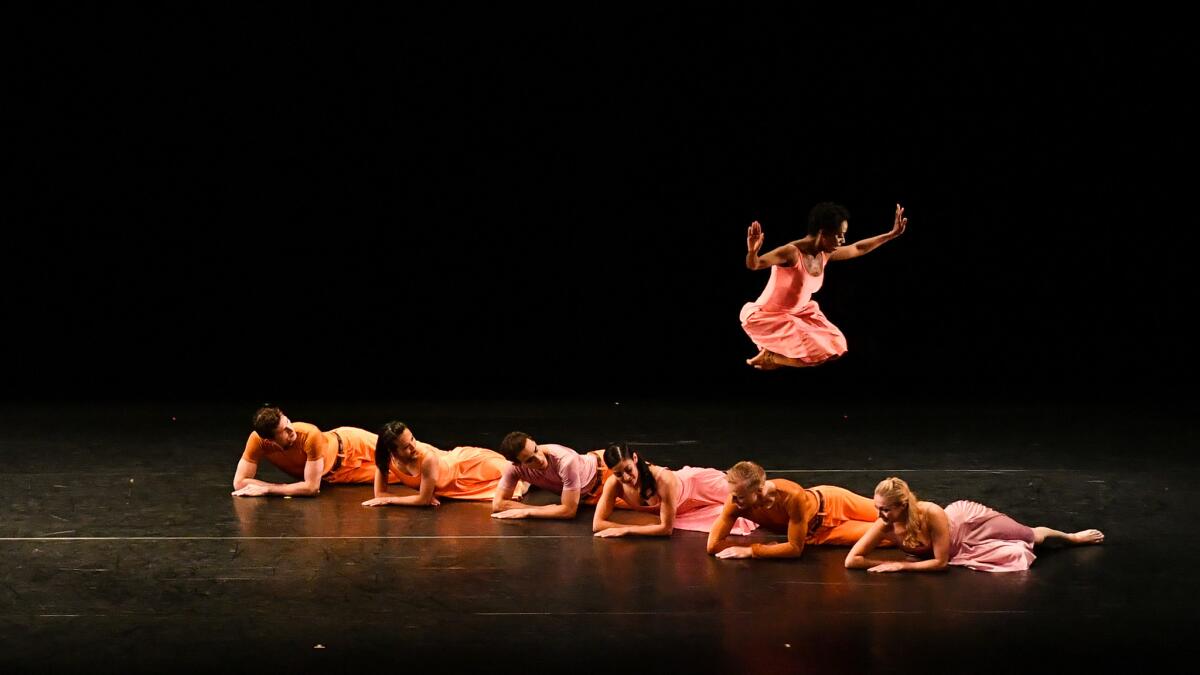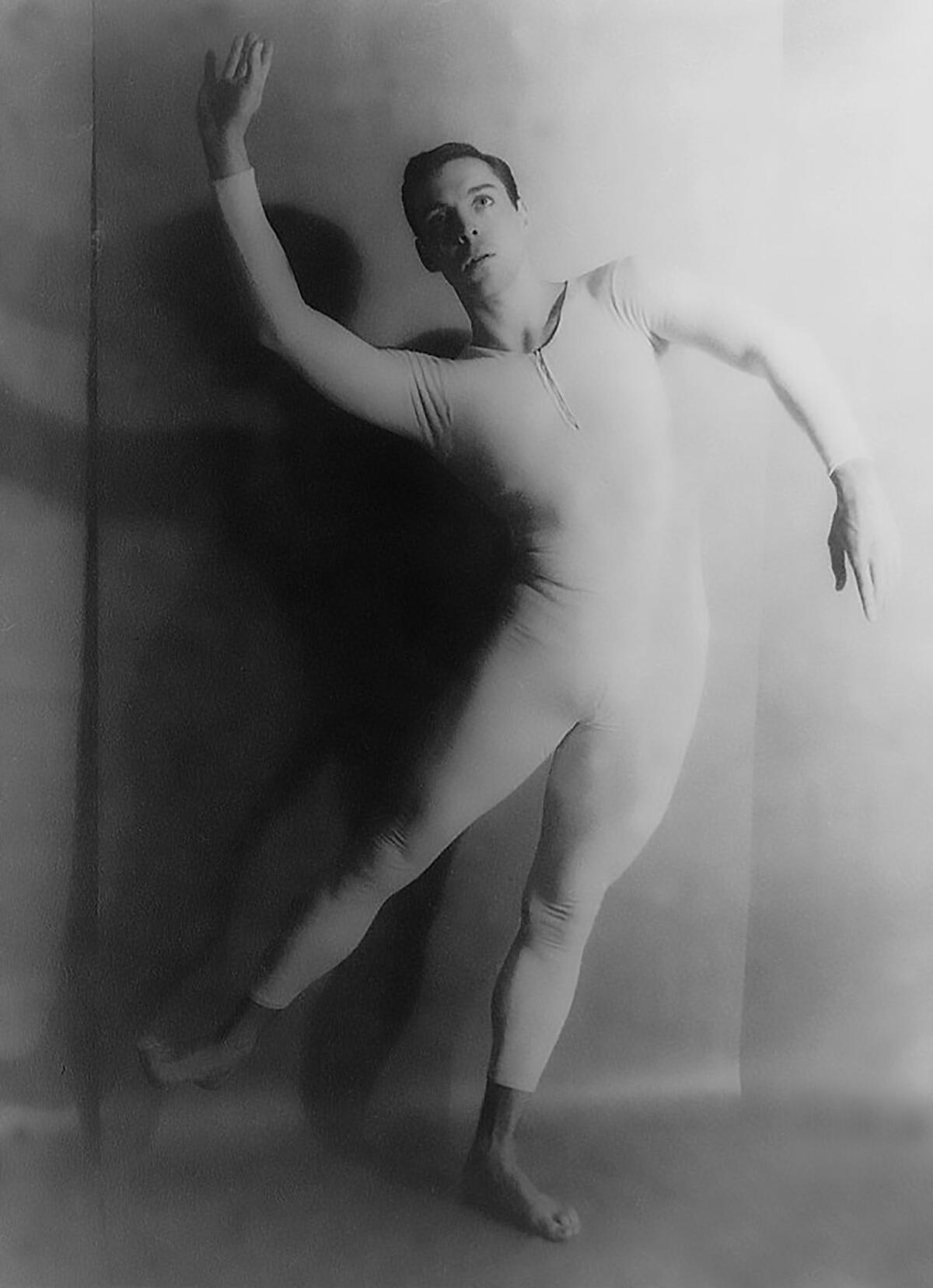Paul Taylor dies: Choreographer, 88, gave modern dance a spirited new voice

- Share via
When the L.A. Times knocked on the door of the Lower East Side apartment in 2010, the man who answered looked like a rumpled professor, not the impish rule breaker who helped to shape modern American dance.
But then conversation turned to Fred Astaire, and the personality of Paul Taylor came through loud and clear. "He looks like a mosquito to me,” Taylor told writer Sylviane Gold. “He's too lightweight. Just to flap your feet around is not enough."
Taylor, the innovative dancer and choreographer whose vast body of work reflected the giddy highs and the depraved lows of the human condition, died Wednesday at Beth Israel Medical Center in Manhattan, spokeswoman Lisa Labrado said. He was 88.
The cause of death was not immediately available, but Labrado said Taylor was in hospice care.
Taylor had worked well into his 80s, venturing into his company's New York studios to choreograph two new pieces a year, and 147 in all.
“The works that satisfy me the most? They're the ones I'm working on,” he told the Associated Press in 2011 while rehearsing “To Make Crops Grow,” his 137th dance. “It's the work process that I like. Once it's done, I want to put everything out of my mind. I'd rather forget it.”
The 64-year-old Paul Taylor Dance Company tours the globe year-round and stages a three-week season every year at Lincoln Center in New York. Taylor named dancer Michael Novak as artistic director designate this year.
“Paul Taylor was one of the world's greatest dance-makers, and his passing deeply saddens not only those of us who worked with him, but also people all over the world whose spirits have been touched by his incomparable art,” Novak said in a statement. “We are grateful for your love and support as we begin to carry on his legacy with the utmost fidelity and devotion.”
In a 2014 L.A. Times review of Paul Taylor Dance, Lewis Segal wrote of the choreographer, “Other societies would long ago have named him a Living National Treasure. Here, at 83, he continues to assert his power to delight, amuse and possibly even anger audiences with programs such as the varied and challenging one his company danced Friday at the Dorothy Chandler Pavilion.”

Taylor's signature work was “Esplanade” (1975), an explosion of joy and athleticism, with Taylor's limber dancers running, skipping, hurling themselves into each other's arms like missiles and tumbling to the floor with abandon, all to two Bach concertos.
The pairing of classical music — especially 18th century Baroque — with a very modern style of dance was one of Taylor's hallmarks. But he also went far and wide with his musical choices, scoring his works not only with symphonies and concertos but ragtime, tango, barbershop quartet and even elevator music.
“Big Bertha” (1970) was most notable for its disturbing content, reflecting Taylor's penchant for giving equal time to the darkest depths of human nature. A wholesome 1950s couple and their young daughter come out to a carnival, but after feeding coins into a robotic creature named Bertha, the family slips into depravity; by the end, the father has raped and killed his pig-tailed daughter.
Even a lighter work, “Company B,” a set of jaunty dances to the music of the Andrews Sisters, has its dark elements: Look closely amid the joyful dances and you see young men as soldiers, shot and crumpling to the ground.
A strong message always emanated from Taylor's work, said dance writer Allan Ullrich. “You know he's always saying something,” Ullrich said. “There should be two words written on his tombstone: ‘He communicated.’”
Paul Belleville Taylor Jr. was born July 29, 1930, during the Great Depression. He began his life in a town outside Pittsburgh but spent much of his youth in the Washington, D.C., area. In his whimsically written autobiography, “Private Domain,” he describes a childhood full of boundary-testing moments: a run-in with police after he and a friend steal a baby stroller from a variety store, or a prep-school stunt involving the excavation of a coffin.
He wound up at Syracuse University, where he studied painting and then joined the swim team, purely to gain scholarship money. The college sport was more work than he expected, but at 6 feet tall and with a huge arm span, he was well-suited to it.

Those arms, swinging through space, would become crucial to his dance work. In fact, Taylor's signature move looks a bit like a swimmer in mid-butterfly stroke, albeit twisted up to the sky.
But the desire to dance came as a shock to Taylor: In his sophomore year, he once wrote, he experienced “something stronger than an itch.”
Taylor transferred to Juilliard in New York, but first he attended a summer dance course where he met, and learned from, the great modern choreographer Martha Graham. Years later, his name would become forever linked with hers as part of the great trio of modern dance choreographers, along with Merce Cunningham. (Graham died in 1991, Cunningham in 2009.)
A year after graduating Juilliard in 1953, Taylor set up his own company, rehearsing in whatever space he could find. He was 24, and his first work was a collaboration with the artist Robert Rauschenberg, “Jack and the Beanstalk.” A year later he joined Graham's company as a soloist. He would dance there for seven seasons while continuing to build his own company.
In 1956 Taylor choreographed one of his odder, much-discussed works: “3 Epitaphs,” the oldest work in his company's repertoire today. For the score, he chose early New Orleans jazz. He set five peculiar creatures — something like futuristic cavemen — gyrating across the stage, dressed head-to-toe in dark gray unitards, designed by Rauschenberg, with reflectors shining on their heads and hands.
In 1959, Taylor collaborated with another giant of dance, George Balanchine of the New York City Ballet, in his “Episodes.” The great Russian-born ballet master asked him to dance, Taylor has said, “like fly in glass of milk.” Balanchine also offered Taylor a permanent job but he turned it down, put off by the formal strictures of ballet.
Taylor's dancing career ended abruptly in 1974 after he collapsed onstage from illness and exhaustion during a performance in Brooklyn. But as a choreographer, he was just getting going: A year later came “Esplanade,” later celebrated as one of the most wondrous works of dance anywhere.
Taylor was known for not only exploring death and despair but also for showing his sense of humor. Sometimes it was merely weird, as in the curious “Phantasmagoria” (2011), which featured a Byzantine nun having a naughty interaction with a toy snake, not to mention an Irish step dancer, a group of Isadora Duncan disciples, a Depression-era Bowery bum and a character with an infectious dancing virus — all set to Renaissance music.
But at other times it had a classic flair, as in the 1995 “Offenbach Overtures,” a foray into pure comedy and clowning to the spirited music of 19th century French composer Jacques Offenbach, where buffoonish soldiers mixed with coquettish can-can dancers.
For Taylor, choreography was a calling he could not deny.
“To put it simply, I make dances because I can't help it,” he wrote in an essay titled “Why I Make Dances.”
“Working on dances has become a way of life, an addiction that at times resembles a fatal disease. Even so, I've no intention of kicking the habit.”
See all of our latest arts news and reviews at latimes.com/arts.
The biggest entertainment stories
Get our big stories about Hollywood, film, television, music, arts, culture and more right in your inbox as soon as they publish.
You may occasionally receive promotional content from the Los Angeles Times.







